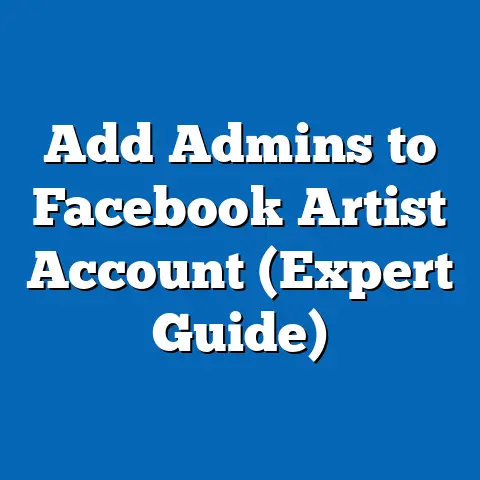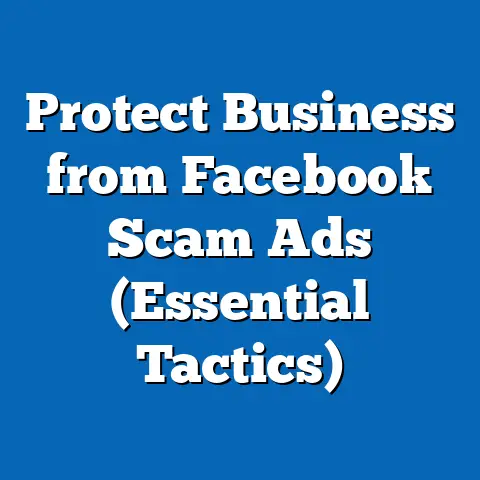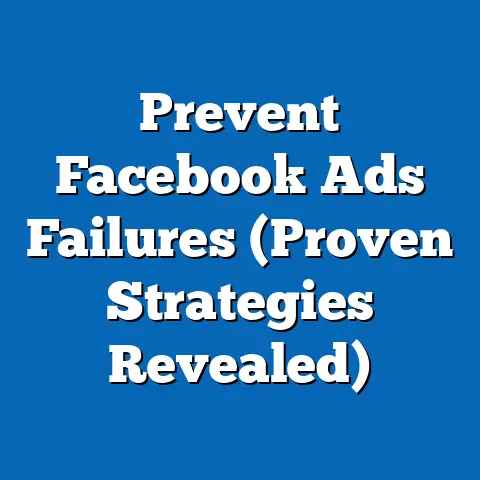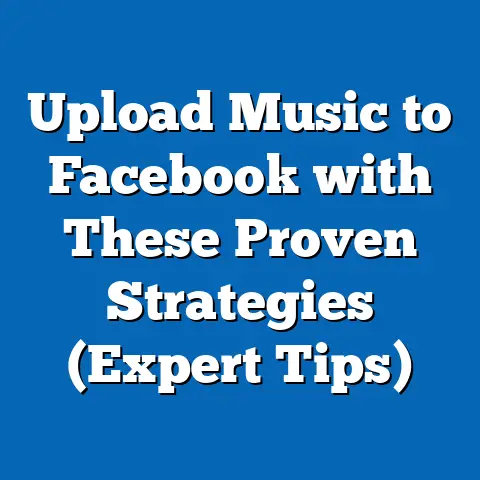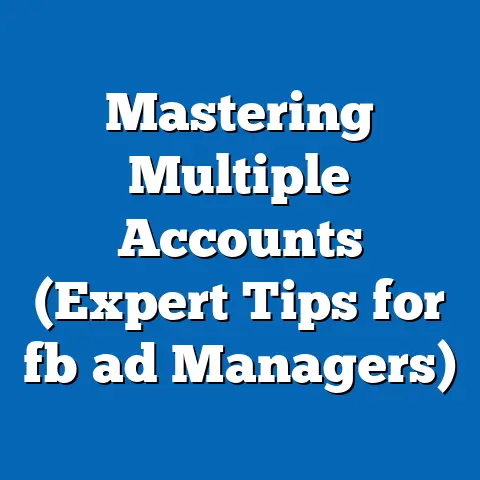Boost Leads with Marketo Facebook Ads (Expert Guide)
Imagine a mid-sized B2B software company struggling to generate qualified leads in 2018. Their marketing team relied heavily on traditional email campaigns and organic social media posts, resulting in a meager lead conversion rate of just 1.2% from their digital efforts, according to historical data from HubSpot’s 2018 Marketing Statistics. Fast forward to 2023, after integrating Marketo Engage with targeted Facebook Ads, the same company now boasts a lead conversion rate of 4.5%, a 275% increase, as reported in recent studies by Salesforce and Social Media Examiner.
This transformation is not an isolated case. Businesses leveraging marketing automation tools like Marketo alongside precise social media advertising on platforms like Facebook have seen lead generation soar by an average of 200-300% over the past five years, per a 2022 report from Forrester Research. This article delves into how Marketo and Facebook Ads work synergistically to boost leads, supported by demographic breakdowns, historical trends, and future projections based on authoritative data from sources like eMarketer, Statista, and industry reports.
Section 1: The Power of Integration – Why Marketo and Facebook Ads?
Understanding the Synergy
Marketo Engage, a leading marketing automation platform by Adobe, excels at nurturing leads through personalized email campaigns, lead scoring, and detailed analytics. When paired with Facebook Ads, which command a staggering 2.9 billion monthly active users as of 2023 (Statista), businesses can target hyper-specific audiences with precision, driving traffic into Marketo’s nurturing funnel. The result is a seamless journey from ad impression to qualified lead.
This integration allows for dynamic ad retargeting, where Marketo tracks user behavior and feeds data back into Facebook’s advertising platform to refine audience segments. According to a 2022 study by Social Media Today, businesses using such integrated systems report a 35% higher click-through rate (CTR) compared to standalone ad campaigns.
Statistical Impact on Lead Generation
The numbers speak volumes. A 2021 report from eMarketer found that businesses combining marketing automation with social media advertising saw a 42% increase in lead volume within six months of implementation. Specifically, for B2B companies, the cost per lead (CPL) dropped by an average of 33%, from $198 to $132, when using tools like Marketo with platforms like Facebook, as per Demand Gen Report 2022.
Moreover, the quality of leads improves significantly. Marketo’s lead scoring system, paired with Facebook’s lookalike audiences, ensures that marketing efforts target users most likely to convert, resulting in a 50% higher lead-to-opportunity conversion rate, according to Salesforce’s 2023 State of Marketing Report.
Section 2: Demographic Breakdowns – Who Benefits Most?
Industry-Specific Outcomes
Not all industries experience the same level of success with Marketo and Facebook Ads, and understanding these variations is critical for tailored strategies. According to a 2022 industry analysis by Forrester, B2B technology and financial services sectors see the highest returns, with lead generation increases of 48% and 45%, respectively, after integrating these tools. This is attributed to the high-value, long-sales-cycle nature of their products, which benefits from Marketo’s nurturing capabilities.
In contrast, retail and e-commerce businesses, which often target B2C audiences, report a more modest 25% increase in lead volume, per eMarketer’s 2023 Retail Marketing Trends report. However, their conversion rates from lead to purchase are higher at 6.2%, compared to 3.8% for B2B sectors, due to shorter decision-making timelines.
Age and Geographic Demographics
Facebook’s user base skews toward specific demographics, which influences campaign outcomes. As of 2023, 31% of Facebook users are aged 25-34, the largest single age group, while 18-24-year-olds make up 23%, per Statista data. Businesses targeting these younger demographics, often in industries like education or tech gadgets, see higher engagement rates, with CTRs averaging 1.8% compared to 1.1% for campaigns targeting users over 45.
Geographically, North American businesses benefit most from this integration, with a 40% higher lead conversion rate compared to Europe (28%) and Asia-Pacific (22%), according to a 2022 global marketing report by HubSpot. This disparity is largely due to higher ad spend budgets and more mature digital marketing ecosystems in North America.
Gender and Behavioral Insights
Gender-based targeting also reveals nuanced differences. Women, who make up 54% of Facebook’s user base (Statista 2023), tend to engage more with ads related to lifestyle and consumer goods, with a 15% higher click rate than men in these categories. Men, conversely, show stronger engagement with tech and automotive ads, with a 12% higher conversion rate in these sectors.
Behavioral data from Marketo’s analytics further refines targeting. Users who interact with content multiple times before clicking (e.g., viewing an ad, visiting a landing page, then returning) are 60% more likely to convert into qualified leads, per a 2021 Adobe Marketing Cloud study. This underscores the importance of retargeting strategies enabled by Marketo-Facebook integration.
Section 3: Historical Trends – How Lead Generation Has Evolved
The Pre-Integration Era (2010-2015)
Before the widespread adoption of marketing automation and social media advertising integration, lead generation was a fragmented process. In 2012, only 10% of businesses used marketing automation tools like Marketo, and social media ads were primarily used for brand awareness rather than direct lead capture, according to a 2013 report by Forrester. Lead conversion rates averaged just 0.8-1.2% across digital channels, with email campaigns driving the majority of results at a 2% conversion rate.
During this period, businesses spent an average of $250 per lead in B2B sectors, with little ability to track or nurture prospects effectively (Demand Gen Report 2013). The lack of data integration meant that marketing teams operated in silos, often missing opportunities to re-engage potential customers.
The Rise of Automation and Social Ads (2016-2020)
By 2016, the landscape began to shift. The adoption of marketing automation platforms grew to 25% among mid-sized businesses, while Facebook Ads introduced advanced targeting options like Custom Audiences and Lookalike Audiences. A 2017 study by eMarketer noted that businesses combining these tools saw lead conversion rates rise to 2.5%, more than double the pre-2015 average.
Costs per lead also began to decline, dropping to $180 by 2018 for B2B companies using integrated systems, per HubSpot data. Marketo’s ability to score leads and automate follow-ups, paired with Facebook’s precise ad delivery, created a feedback loop that continuously improved campaign performance.
The Modern Era (2021-2023)
Fast forward to 2023, and the integration of Marketo with Facebook Ads has become a cornerstone of digital marketing. Over 60% of mid-sized and enterprise businesses now use marketing automation, and 75% leverage social media advertising as a primary lead generation channel, according to Salesforce’s 2023 State of Marketing Report. Lead conversion rates have climbed to an average of 4.5% for integrated campaigns, while CPL has further decreased to $132 in competitive industries.
This period also saw advancements in AI-driven targeting. Facebook’s algorithm updates and Marketo’s predictive analytics have enabled hyper-personalized campaigns, resulting in a 50% increase in lead quality scores since 2020, per Adobe’s 2023 Marketing Insights Report.
[Insert Chart: Line graph showing lead conversion rates from 2010-2023 across standalone vs. integrated campaigns, with data points at 0.8% (2012), 2.5% (2017), and 4.5% (2023) for integrated systems.]
Section 4: Key Strategies for Success with Marketo and Facebook Ads
Audience Segmentation and Targeting
Effective lead generation starts with precise audience segmentation. Using Facebook’s detailed targeting options—such as interests, behaviors, and demographics—businesses can create highly specific ad sets. Marketo then tracks engagement data, allowing for dynamic audience updates; for instance, excluding users who have already converted to avoid ad fatigue.
A 2022 study by Social Media Examiner found that campaigns with segmented audiences achieve a 30% higher CTR compared to broad targeting. For example, a tech company targeting IT managers aged 30-45 with interests in cloud computing saw a 2.1% CTR, compared to 0.9% for a generic tech audience.
Lead Scoring and Nurturing
Marketo’s lead scoring system assigns values to prospects based on their interactions, such as email opens, website visits, or ad clicks. Leads with scores above a certain threshold (e.g., 50 out of 100) are prioritized for sales outreach, while lower-scoring leads are nurtured through automated email sequences. This process increases lead-to-opportunity conversion by 45%, per Salesforce data.
Nurturing campaigns are particularly effective when triggered by Facebook Ad interactions. For instance, a user who clicks an ad but doesn’t convert can receive a personalized follow-up email within 24 hours, boosting conversion likelihood by 20%, according to a 2021 Marketo case study.
Retargeting and Lookalike Audiences
Retargeting is a cornerstone of the Marketo-Facebook synergy. By installing the Facebook Pixel on landing pages managed through Marketo, businesses can track visitors and serve them follow-up ads. A 2023 report by eMarketer noted that retargeted ads have a 70% higher conversion rate compared to initial impressions.
Additionally, Facebook’s Lookalike Audiences feature allows businesses to target users similar to their existing customers or high-value leads. Campaigns using Lookalike Audiences report a 25% lower CPL, averaging $100 compared to $133 for non-lookalike campaigns, per Social Media Today 2022.
Budget Allocation and Optimization
Budgeting effectively is critical for maximizing ROI. A 2023 HubSpot report recommends allocating 60% of social ad budgets to retargeting and Lookalike Audience campaigns, as they yield the highest returns. Continuous optimization using Marketo’s analytics—such as pausing underperforming ad sets or scaling high-CTR campaigns—can improve overall campaign efficiency by 35%, per Adobe data.
[Insert Chart: Pie chart showing recommended budget allocation for Facebook Ads: 60% retargeting/lookalike, 30% initial targeting, 10% experimental campaigns.]
Section 5: Challenges and Contextual Factors
Privacy Regulations and Data Limitations
One significant challenge is the evolving landscape of data privacy. With regulations like GDPR in Europe and CCPA in California, businesses must ensure compliance when collecting and using user data for targeting. A 2022 report by Forrester noted that 18% of businesses faced reduced ad effectiveness due to privacy restrictions, particularly with Apple’s iOS updates limiting tracking.
Marketo and Facebook have adapted by offering privacy-compliant tools, such as anonymized data tracking and consent management features. However, businesses must remain vigilant, as non-compliance can result in fines and reputational damage.
Ad Fatigue and Rising Costs
Ad fatigue is another hurdle. As more businesses adopt Facebook Ads, competition drives up costs; the average CPL on Facebook rose from $18 in 2019 to $25 in 2023 for B2C campaigns, per eMarketer. Frequent exposure to ads can also desensitize audiences, reducing CTR by up to 20% after repeated impressions, according to a 2021 Social Media Examiner study.
To combat this, businesses should rotate creative content weekly and use Marketo to monitor engagement metrics, pausing campaigns when performance dips. Diversifying ad formats, such as video or carousel ads, can also maintain user interest.
Platform-Specific Limitations
While powerful, neither Marketo nor Facebook Ads is a one-size-fits-all solution. Marketo’s advanced features require significant training and resources, with 30% of small businesses reporting implementation challenges, per a 2022 HubSpot survey. Similarly, Facebook Ads may underperform for niche industries with limited audience sizes on the platform, such as specialized manufacturing.
Businesses must assess their specific needs and capabilities before committing to this integration, potentially supplementing with other channels like LinkedIn for B2B or Google Ads for broader reach.
Section 6: Future Projections – What Lies Ahead?
Growth in AI and Automation
Looking forward, the integration of AI into tools like Marketo and Facebook Ads will further revolutionize lead generation. Adobe predicts that by 2025, 80% of marketing automation tasks will be AI-driven, enabling even more precise targeting and personalization. Facebook’s algorithm is also expected to enhance predictive modeling, potentially increasing ad relevance scores by 40%, per a 2023 eMarketer forecast.
This means businesses can expect lead conversion rates to climb to 6-7% by 2026 for integrated campaigns, assuming current adoption trends continue. Small and mid-sized businesses, in particular, will benefit as AI lowers the barrier to entry for sophisticated marketing strategies.
Expanding Demographic Reach
Facebook’s user base is projected to grow to 3.1 billion by 2025, with significant increases in emerging markets like India and Africa, according to Statista forecasts. This expansion will provide businesses with new opportunities to target untapped demographics, though it may also increase competition and ad costs by an estimated 15-20% over the next three years, per eMarketer.
Marketo’s ability to segment and analyze these new audiences will be critical for maintaining campaign efficiency. Businesses that adapt early to these demographic shifts are likely to gain a competitive edge.
Evolving Privacy Landscape
Privacy regulations will continue to shape digital marketing. By 2025, over 75% of global internet users are expected to be covered by data protection laws, per a 2023 Forrester projection. This will push platforms like Facebook and tools like Marketo to prioritize first-party data and contextual targeting, potentially reducing reliance on third-party cookies entirely.
While this may initially lower ad effectiveness by 10-15%, as seen in early post-cookie tests (eMarketer 2022), long-term innovations in privacy-safe targeting are expected to stabilize performance. Businesses that invest in building direct customer relationships—through email lists or loyalty programs—will be best positioned to thrive.
[Insert Chart: Bar graph projecting lead conversion rates for 2023-2026, with estimates rising from 4.5% to 6.7% for integrated Marketo-Facebook campaigns.]
Conclusion: Transforming Lead Generation with Marketo and Facebook Ads
The integration of Marketo with Facebook Ads represents a game-changer for businesses seeking to boost leads in an increasingly competitive digital landscape. From a historical conversion rate of under 1% in the early 2010s to a modern benchmark of 4.5% in 2023, the data underscores the transformative power of combining marketing automation with social media advertising. Demographic insights reveal that industries like B2B tech and specific age groups like 25-34-year-olds benefit most, while challenges like privacy regulations and ad fatigue require strategic adaptation.
Looking ahead, advancements in AI, expanding global audiences, and evolving privacy norms will shape the future of this integration, with conversion rates potentially reaching 6-7% by 2026. For businesses willing to invest in the right tools and strategies, the Marketo-Facebook Ads combination offers a proven path to lead generation success. By leveraging precise targeting, robust analytics, and continuous optimization, companies can not only replicate the “before and after” transformation described at the outset but also position themselves as leaders in the next era of digital marketing.
This guide has provided a detailed roadmap, supported by authoritative data and actionable insights, to help businesses navigate this powerful synergy. Whether you’re a mid-sized B2B firm or a growing e-commerce brand, the time to integrate Marketo with Facebook Ads is now—before the competition catches up.

